Case Study Analysis: Infectious Conjunctivitis in a Nursing Home
VerifiedAdded on 2022/12/22
|9
|1933
|26
Case Study
AI Summary
This case study analyzes a scenario of infectious conjunctivitis in a nursing home, focusing on a patient named John. It begins by defining infectious conjunctivitis and identifying the causative microorganisms, with a justification for the involvement of Staphylococcus aureus and Adenovirus. The study then explores the mechanism of action and adverse reactions of gentamicin, a common antibiotic used in treatment, and explains the physiological basis of the signs observed, including redness, sticky discharge, and swelling of the eyes. It further delves into infection control issues, such as the contagiousness of the infection and the potential for antimicrobial resistance. The study also examines the transmission of the infection, particularly from John to another resident, Mary, and proposes effective procedures to break the chain of infection, emphasizing hand hygiene and antibiotic use. References are provided to support the analysis.
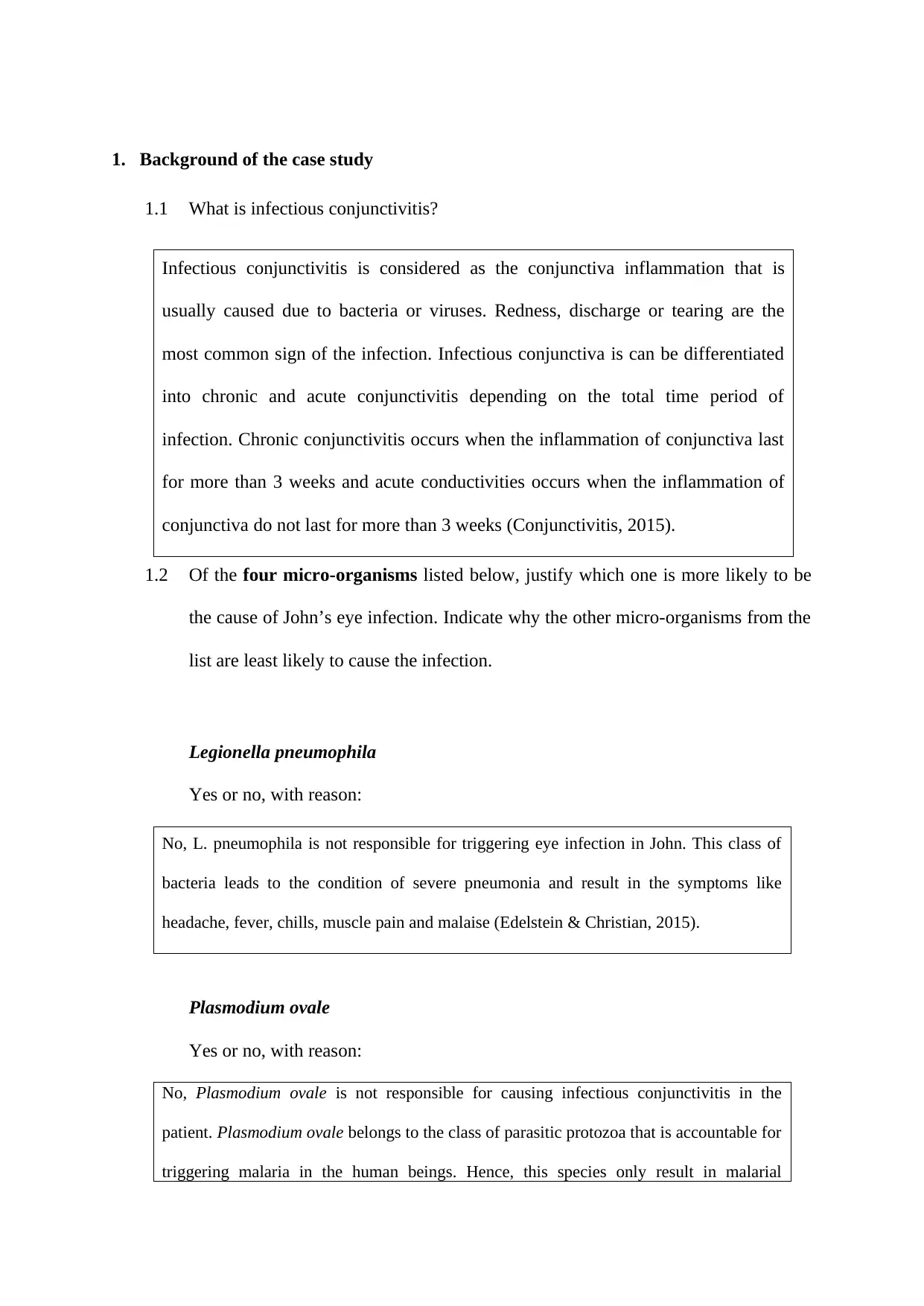
1. Background of the case study
1.1 What is infectious conjunctivitis?
Infectious conjunctivitis is considered as the conjunctiva inflammation that is
usually caused due to bacteria or viruses. Redness, discharge or tearing are the
most common sign of the infection. Infectious conjunctiva is can be differentiated
into chronic and acute conjunctivitis depending on the total time period of
infection. Chronic conjunctivitis occurs when the inflammation of conjunctiva last
for more than 3 weeks and acute conductivities occurs when the inflammation of
conjunctiva do not last for more than 3 weeks (Conjunctivitis, 2015).
1.2 Of the four micro-organisms listed below, justify which one is more likely to be
the cause of John’s eye infection. Indicate why the other micro-organisms from the
list are least likely to cause the infection.
Legionella pneumophila
Yes or no, with reason:
No, L. pneumophila is not responsible for triggering eye infection in John. This class of
bacteria leads to the condition of severe pneumonia and result in the symptoms like
headache, fever, chills, muscle pain and malaise (Edelstein & Christian, 2015).
Plasmodium ovale
Yes or no, with reason:
No, Plasmodium ovale is not responsible for causing infectious conjunctivitis in the
patient. Plasmodium ovale belongs to the class of parasitic protozoa that is accountable for
triggering malaria in the human beings. Hence, this species only result in malarial
1.1 What is infectious conjunctivitis?
Infectious conjunctivitis is considered as the conjunctiva inflammation that is
usually caused due to bacteria or viruses. Redness, discharge or tearing are the
most common sign of the infection. Infectious conjunctiva is can be differentiated
into chronic and acute conjunctivitis depending on the total time period of
infection. Chronic conjunctivitis occurs when the inflammation of conjunctiva last
for more than 3 weeks and acute conductivities occurs when the inflammation of
conjunctiva do not last for more than 3 weeks (Conjunctivitis, 2015).
1.2 Of the four micro-organisms listed below, justify which one is more likely to be
the cause of John’s eye infection. Indicate why the other micro-organisms from the
list are least likely to cause the infection.
Legionella pneumophila
Yes or no, with reason:
No, L. pneumophila is not responsible for triggering eye infection in John. This class of
bacteria leads to the condition of severe pneumonia and result in the symptoms like
headache, fever, chills, muscle pain and malaise (Edelstein & Christian, 2015).
Plasmodium ovale
Yes or no, with reason:
No, Plasmodium ovale is not responsible for causing infectious conjunctivitis in the
patient. Plasmodium ovale belongs to the class of parasitic protozoa that is accountable for
triggering malaria in the human beings. Hence, this species only result in malarial
Paraphrase This Document
Need a fresh take? Get an instant paraphrase of this document with our AI Paraphraser
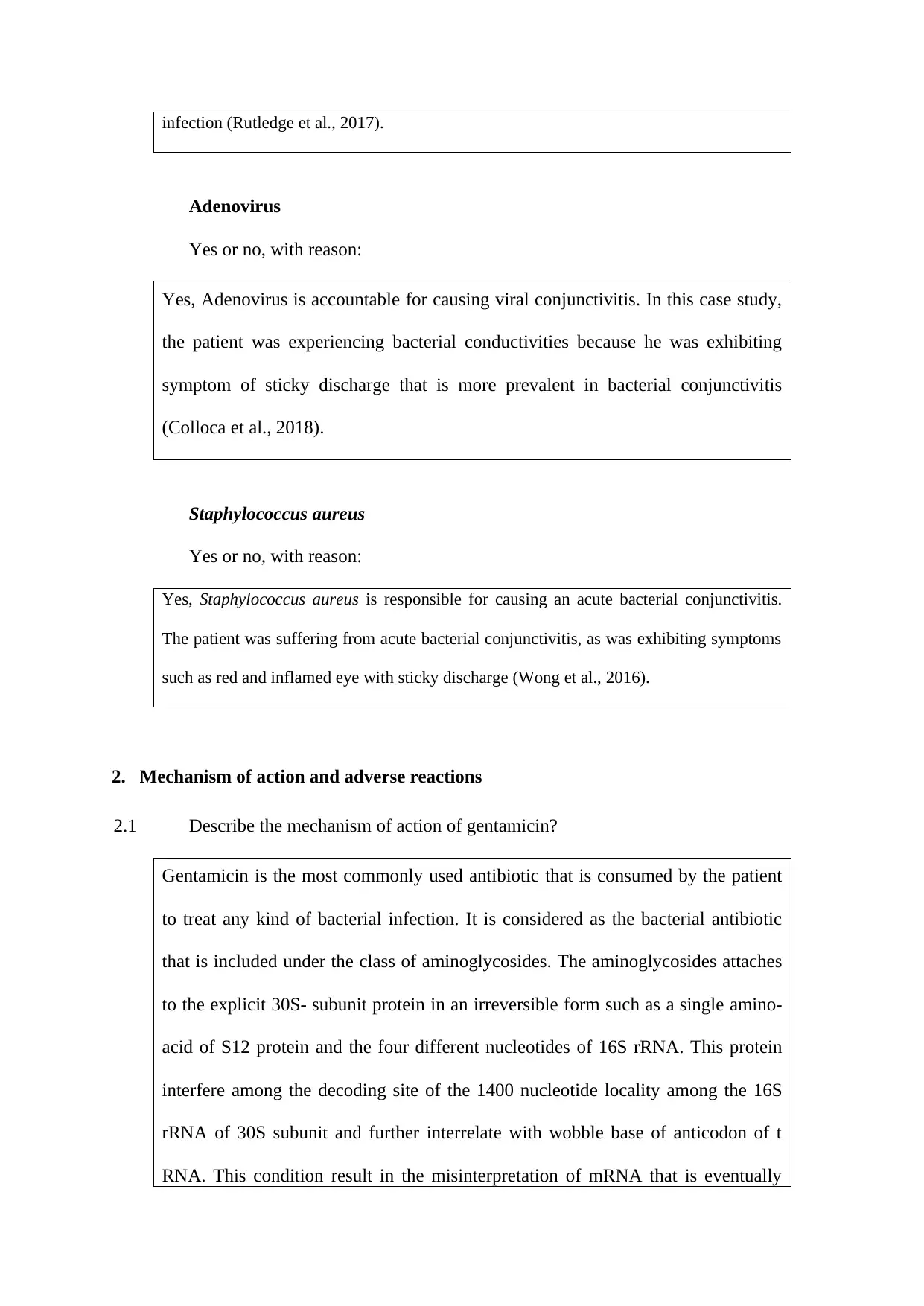
infection (Rutledge et al., 2017).
Adenovirus
Yes or no, with reason:
Yes, Adenovirus is accountable for causing viral conjunctivitis. In this case study,
the patient was experiencing bacterial conductivities because he was exhibiting
symptom of sticky discharge that is more prevalent in bacterial conjunctivitis
(Colloca et al., 2018).
Staphylococcus aureus
Yes or no, with reason:
Yes, Staphylococcus aureus is responsible for causing an acute bacterial conjunctivitis.
The patient was suffering from acute bacterial conjunctivitis, as was exhibiting symptoms
such as red and inflamed eye with sticky discharge (Wong et al., 2016).
2. Mechanism of action and adverse reactions
2.1 Describe the mechanism of action of gentamicin?
Gentamicin is the most commonly used antibiotic that is consumed by the patient
to treat any kind of bacterial infection. It is considered as the bacterial antibiotic
that is included under the class of aminoglycosides. The aminoglycosides attaches
to the explicit 30S- subunit protein in an irreversible form such as a single amino-
acid of S12 protein and the four different nucleotides of 16S rRNA. This protein
interfere among the decoding site of the 1400 nucleotide locality among the 16S
rRNA of 30S subunit and further interrelate with wobble base of anticodon of t
RNA. This condition result in the misinterpretation of mRNA that is eventually
Adenovirus
Yes or no, with reason:
Yes, Adenovirus is accountable for causing viral conjunctivitis. In this case study,
the patient was experiencing bacterial conductivities because he was exhibiting
symptom of sticky discharge that is more prevalent in bacterial conjunctivitis
(Colloca et al., 2018).
Staphylococcus aureus
Yes or no, with reason:
Yes, Staphylococcus aureus is responsible for causing an acute bacterial conjunctivitis.
The patient was suffering from acute bacterial conjunctivitis, as was exhibiting symptoms
such as red and inflamed eye with sticky discharge (Wong et al., 2016).
2. Mechanism of action and adverse reactions
2.1 Describe the mechanism of action of gentamicin?
Gentamicin is the most commonly used antibiotic that is consumed by the patient
to treat any kind of bacterial infection. It is considered as the bacterial antibiotic
that is included under the class of aminoglycosides. The aminoglycosides attaches
to the explicit 30S- subunit protein in an irreversible form such as a single amino-
acid of S12 protein and the four different nucleotides of 16S rRNA. This protein
interfere among the decoding site of the 1400 nucleotide locality among the 16S
rRNA of 30S subunit and further interrelate with wobble base of anticodon of t
RNA. This condition result in the misinterpretation of mRNA that is eventually
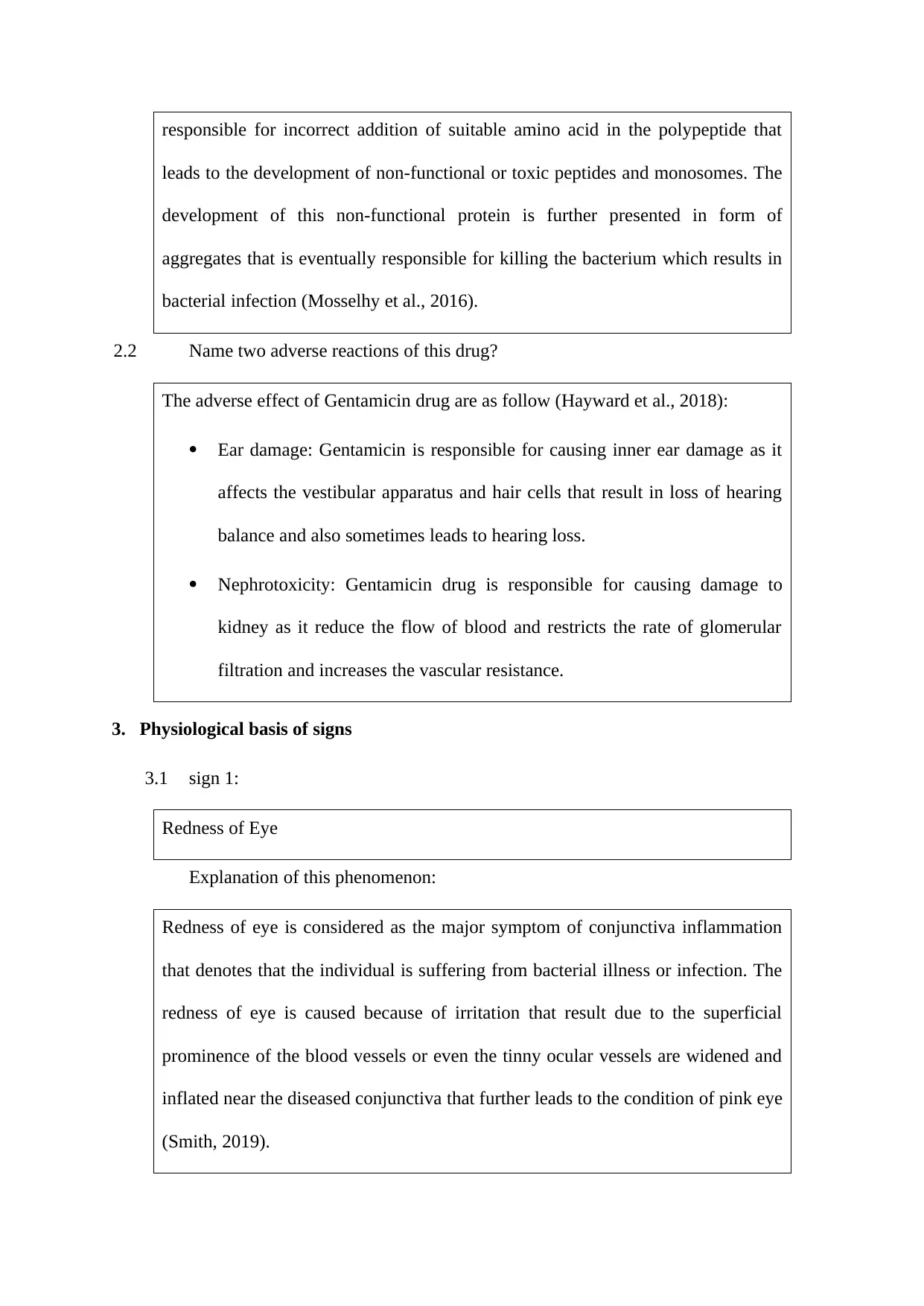
responsible for incorrect addition of suitable amino acid in the polypeptide that
leads to the development of non-functional or toxic peptides and monosomes. The
development of this non-functional protein is further presented in form of
aggregates that is eventually responsible for killing the bacterium which results in
bacterial infection (Mosselhy et al., 2016).
2.2 Name two adverse reactions of this drug?
The adverse effect of Gentamicin drug are as follow (Hayward et al., 2018):
Ear damage: Gentamicin is responsible for causing inner ear damage as it
affects the vestibular apparatus and hair cells that result in loss of hearing
balance and also sometimes leads to hearing loss.
Nephrotoxicity: Gentamicin drug is responsible for causing damage to
kidney as it reduce the flow of blood and restricts the rate of glomerular
filtration and increases the vascular resistance.
3. Physiological basis of signs
3.1 sign 1:
Redness of Eye
Explanation of this phenomenon:
Redness of eye is considered as the major symptom of conjunctiva inflammation
that denotes that the individual is suffering from bacterial illness or infection. The
redness of eye is caused because of irritation that result due to the superficial
prominence of the blood vessels or even the tinny ocular vessels are widened and
inflated near the diseased conjunctiva that further leads to the condition of pink eye
(Smith, 2019).
leads to the development of non-functional or toxic peptides and monosomes. The
development of this non-functional protein is further presented in form of
aggregates that is eventually responsible for killing the bacterium which results in
bacterial infection (Mosselhy et al., 2016).
2.2 Name two adverse reactions of this drug?
The adverse effect of Gentamicin drug are as follow (Hayward et al., 2018):
Ear damage: Gentamicin is responsible for causing inner ear damage as it
affects the vestibular apparatus and hair cells that result in loss of hearing
balance and also sometimes leads to hearing loss.
Nephrotoxicity: Gentamicin drug is responsible for causing damage to
kidney as it reduce the flow of blood and restricts the rate of glomerular
filtration and increases the vascular resistance.
3. Physiological basis of signs
3.1 sign 1:
Redness of Eye
Explanation of this phenomenon:
Redness of eye is considered as the major symptom of conjunctiva inflammation
that denotes that the individual is suffering from bacterial illness or infection. The
redness of eye is caused because of irritation that result due to the superficial
prominence of the blood vessels or even the tinny ocular vessels are widened and
inflated near the diseased conjunctiva that further leads to the condition of pink eye
(Smith, 2019).
⊘ This is a preview!⊘
Do you want full access?
Subscribe today to unlock all pages.

Trusted by 1+ million students worldwide
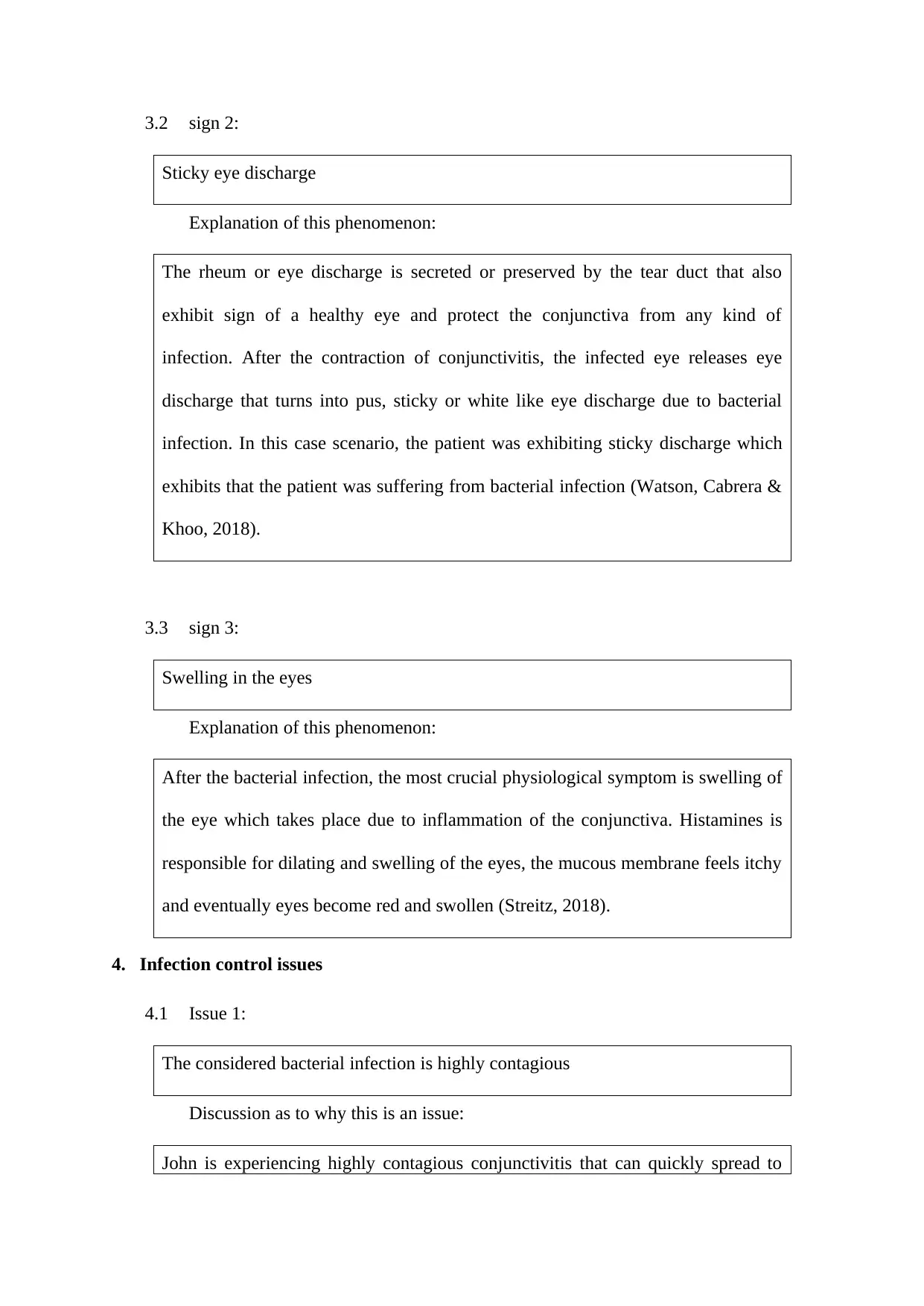
3.2 sign 2:
Sticky eye discharge
Explanation of this phenomenon:
The rheum or eye discharge is secreted or preserved by the tear duct that also
exhibit sign of a healthy eye and protect the conjunctiva from any kind of
infection. After the contraction of conjunctivitis, the infected eye releases eye
discharge that turns into pus, sticky or white like eye discharge due to bacterial
infection. In this case scenario, the patient was exhibiting sticky discharge which
exhibits that the patient was suffering from bacterial infection (Watson, Cabrera &
Khoo, 2018).
3.3 sign 3:
Swelling in the eyes
Explanation of this phenomenon:
After the bacterial infection, the most crucial physiological symptom is swelling of
the eye which takes place due to inflammation of the conjunctiva. Histamines is
responsible for dilating and swelling of the eyes, the mucous membrane feels itchy
and eventually eyes become red and swollen (Streitz, 2018).
4. Infection control issues
4.1 Issue 1:
The considered bacterial infection is highly contagious
Discussion as to why this is an issue:
John is experiencing highly contagious conjunctivitis that can quickly spread to
Sticky eye discharge
Explanation of this phenomenon:
The rheum or eye discharge is secreted or preserved by the tear duct that also
exhibit sign of a healthy eye and protect the conjunctiva from any kind of
infection. After the contraction of conjunctivitis, the infected eye releases eye
discharge that turns into pus, sticky or white like eye discharge due to bacterial
infection. In this case scenario, the patient was exhibiting sticky discharge which
exhibits that the patient was suffering from bacterial infection (Watson, Cabrera &
Khoo, 2018).
3.3 sign 3:
Swelling in the eyes
Explanation of this phenomenon:
After the bacterial infection, the most crucial physiological symptom is swelling of
the eye which takes place due to inflammation of the conjunctiva. Histamines is
responsible for dilating and swelling of the eyes, the mucous membrane feels itchy
and eventually eyes become red and swollen (Streitz, 2018).
4. Infection control issues
4.1 Issue 1:
The considered bacterial infection is highly contagious
Discussion as to why this is an issue:
John is experiencing highly contagious conjunctivitis that can quickly spread to
Paraphrase This Document
Need a fresh take? Get an instant paraphrase of this document with our AI Paraphraser
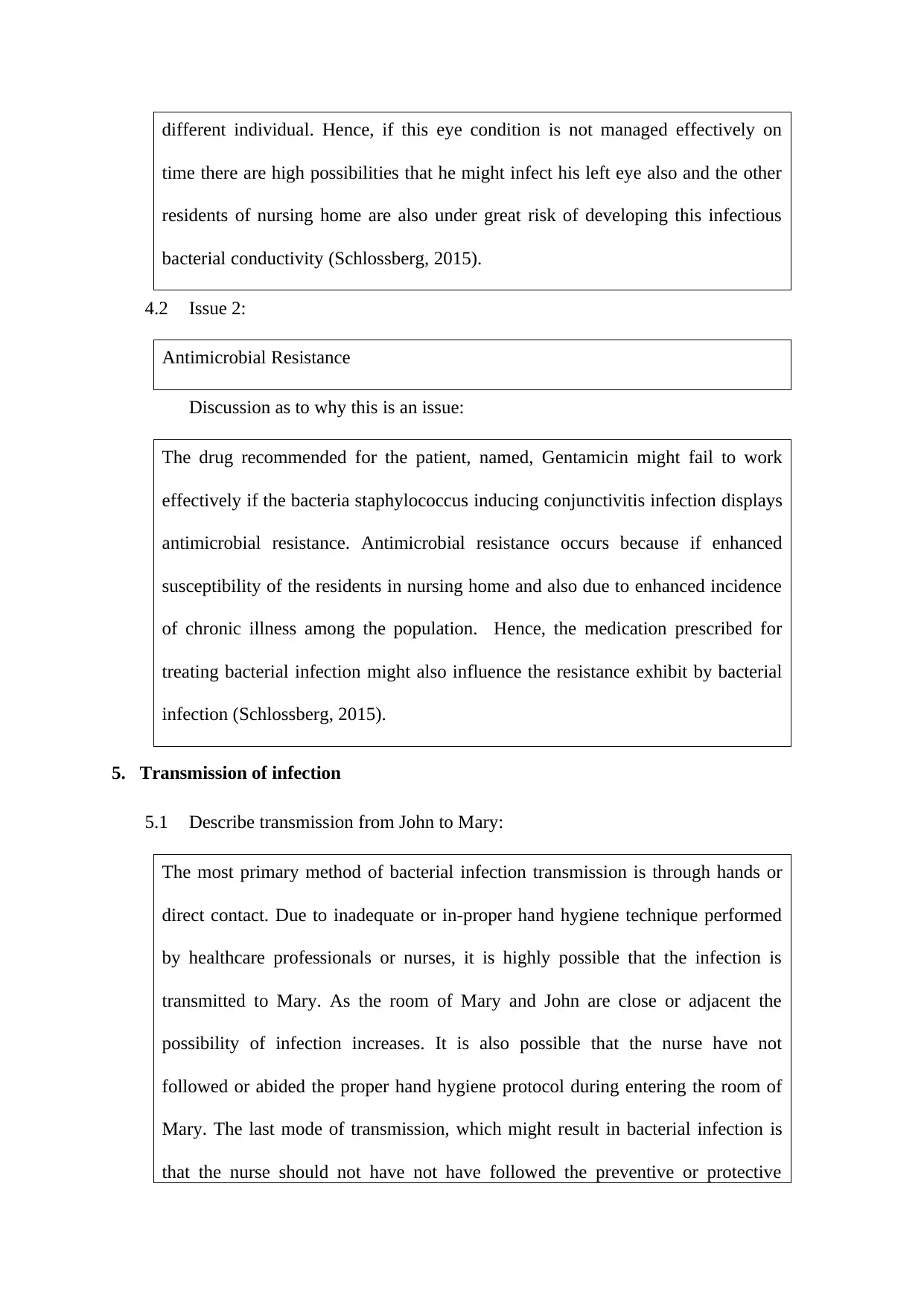
different individual. Hence, if this eye condition is not managed effectively on
time there are high possibilities that he might infect his left eye also and the other
residents of nursing home are also under great risk of developing this infectious
bacterial conductivity (Schlossberg, 2015).
4.2 Issue 2:
Antimicrobial Resistance
Discussion as to why this is an issue:
The drug recommended for the patient, named, Gentamicin might fail to work
effectively if the bacteria staphylococcus inducing conjunctivitis infection displays
antimicrobial resistance. Antimicrobial resistance occurs because if enhanced
susceptibility of the residents in nursing home and also due to enhanced incidence
of chronic illness among the population. Hence, the medication prescribed for
treating bacterial infection might also influence the resistance exhibit by bacterial
infection (Schlossberg, 2015).
5. Transmission of infection
5.1 Describe transmission from John to Mary:
The most primary method of bacterial infection transmission is through hands or
direct contact. Due to inadequate or in-proper hand hygiene technique performed
by healthcare professionals or nurses, it is highly possible that the infection is
transmitted to Mary. As the room of Mary and John are close or adjacent the
possibility of infection increases. It is also possible that the nurse have not
followed or abided the proper hand hygiene protocol during entering the room of
Mary. The last mode of transmission, which might result in bacterial infection is
that the nurse should not have not have followed the preventive or protective
time there are high possibilities that he might infect his left eye also and the other
residents of nursing home are also under great risk of developing this infectious
bacterial conductivity (Schlossberg, 2015).
4.2 Issue 2:
Antimicrobial Resistance
Discussion as to why this is an issue:
The drug recommended for the patient, named, Gentamicin might fail to work
effectively if the bacteria staphylococcus inducing conjunctivitis infection displays
antimicrobial resistance. Antimicrobial resistance occurs because if enhanced
susceptibility of the residents in nursing home and also due to enhanced incidence
of chronic illness among the population. Hence, the medication prescribed for
treating bacterial infection might also influence the resistance exhibit by bacterial
infection (Schlossberg, 2015).
5. Transmission of infection
5.1 Describe transmission from John to Mary:
The most primary method of bacterial infection transmission is through hands or
direct contact. Due to inadequate or in-proper hand hygiene technique performed
by healthcare professionals or nurses, it is highly possible that the infection is
transmitted to Mary. As the room of Mary and John are close or adjacent the
possibility of infection increases. It is also possible that the nurse have not
followed or abided the proper hand hygiene protocol during entering the room of
Mary. The last mode of transmission, which might result in bacterial infection is
that the nurse should not have not have followed the preventive or protective
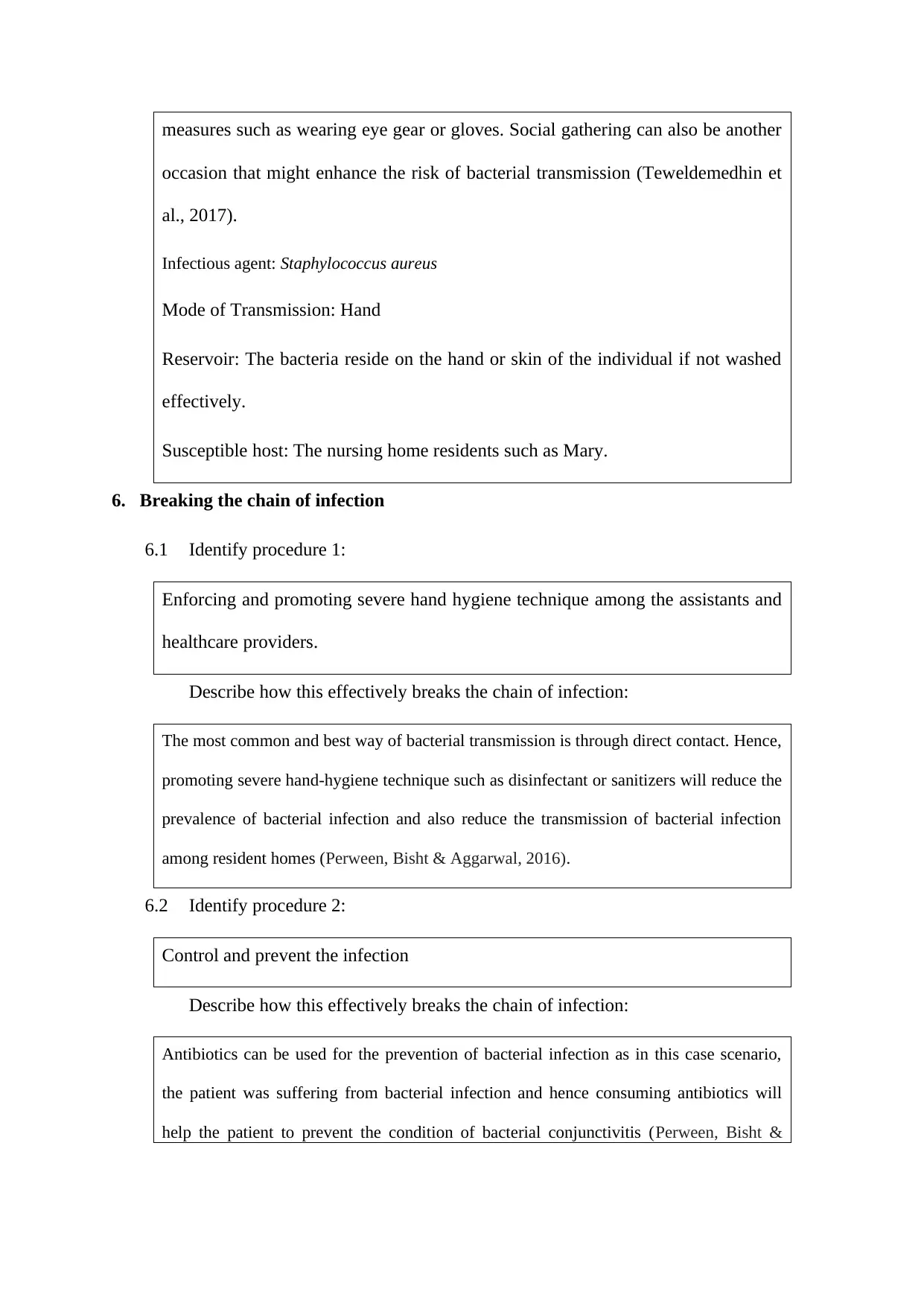
measures such as wearing eye gear or gloves. Social gathering can also be another
occasion that might enhance the risk of bacterial transmission (Teweldemedhin et
al., 2017).
Infectious agent: Staphylococcus aureus
Mode of Transmission: Hand
Reservoir: The bacteria reside on the hand or skin of the individual if not washed
effectively.
Susceptible host: The nursing home residents such as Mary.
6. Breaking the chain of infection
6.1 Identify procedure 1:
Enforcing and promoting severe hand hygiene technique among the assistants and
healthcare providers.
Describe how this effectively breaks the chain of infection:
The most common and best way of bacterial transmission is through direct contact. Hence,
promoting severe hand-hygiene technique such as disinfectant or sanitizers will reduce the
prevalence of bacterial infection and also reduce the transmission of bacterial infection
among resident homes (Perween, Bisht & Aggarwal, 2016).
6.2 Identify procedure 2:
Control and prevent the infection
Describe how this effectively breaks the chain of infection:
Antibiotics can be used for the prevention of bacterial infection as in this case scenario,
the patient was suffering from bacterial infection and hence consuming antibiotics will
help the patient to prevent the condition of bacterial conjunctivitis (Perween, Bisht &
occasion that might enhance the risk of bacterial transmission (Teweldemedhin et
al., 2017).
Infectious agent: Staphylococcus aureus
Mode of Transmission: Hand
Reservoir: The bacteria reside on the hand or skin of the individual if not washed
effectively.
Susceptible host: The nursing home residents such as Mary.
6. Breaking the chain of infection
6.1 Identify procedure 1:
Enforcing and promoting severe hand hygiene technique among the assistants and
healthcare providers.
Describe how this effectively breaks the chain of infection:
The most common and best way of bacterial transmission is through direct contact. Hence,
promoting severe hand-hygiene technique such as disinfectant or sanitizers will reduce the
prevalence of bacterial infection and also reduce the transmission of bacterial infection
among resident homes (Perween, Bisht & Aggarwal, 2016).
6.2 Identify procedure 2:
Control and prevent the infection
Describe how this effectively breaks the chain of infection:
Antibiotics can be used for the prevention of bacterial infection as in this case scenario,
the patient was suffering from bacterial infection and hence consuming antibiotics will
help the patient to prevent the condition of bacterial conjunctivitis (Perween, Bisht &
⊘ This is a preview!⊘
Do you want full access?
Subscribe today to unlock all pages.

Trusted by 1+ million students worldwide

Aggarwal, 2016).
Paraphrase This Document
Need a fresh take? Get an instant paraphrase of this document with our AI Paraphraser
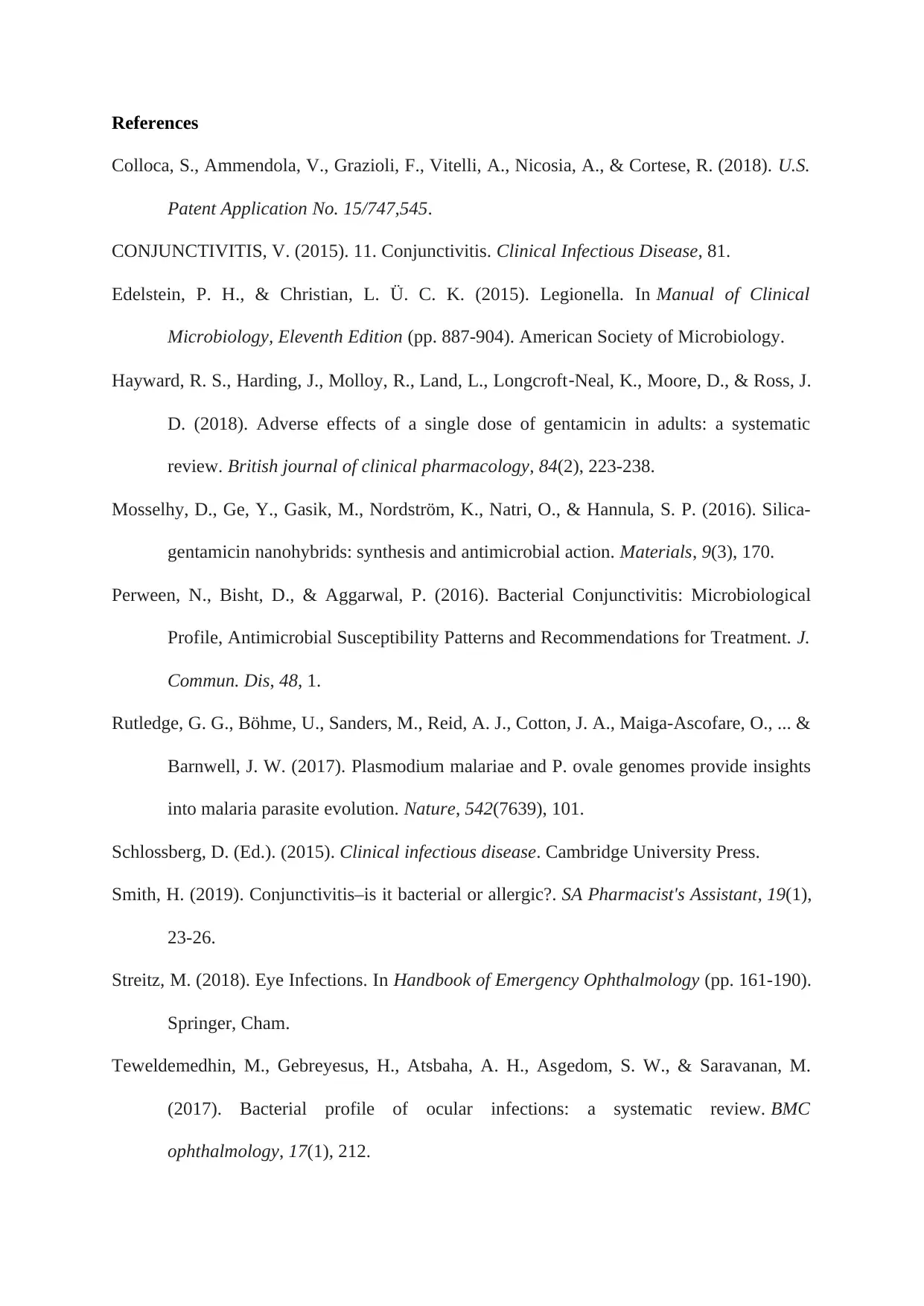
References
Colloca, S., Ammendola, V., Grazioli, F., Vitelli, A., Nicosia, A., & Cortese, R. (2018). U.S.
Patent Application No. 15/747,545.
CONJUNCTIVITIS, V. (2015). 11. Conjunctivitis. Clinical Infectious Disease, 81.
Edelstein, P. H., & Christian, L. Ü. C. K. (2015). Legionella. In Manual of Clinical
Microbiology, Eleventh Edition (pp. 887-904). American Society of Microbiology.
Hayward, R. S., Harding, J., Molloy, R., Land, L., Longcroft‐Neal, K., Moore, D., & Ross, J.
D. (2018). Adverse effects of a single dose of gentamicin in adults: a systematic
review. British journal of clinical pharmacology, 84(2), 223-238.
Mosselhy, D., Ge, Y., Gasik, M., Nordström, K., Natri, O., & Hannula, S. P. (2016). Silica-
gentamicin nanohybrids: synthesis and antimicrobial action. Materials, 9(3), 170.
Perween, N., Bisht, D., & Aggarwal, P. (2016). Bacterial Conjunctivitis: Microbiological
Profile, Antimicrobial Susceptibility Patterns and Recommendations for Treatment. J.
Commun. Dis, 48, 1.
Rutledge, G. G., Böhme, U., Sanders, M., Reid, A. J., Cotton, J. A., Maiga-Ascofare, O., ... &
Barnwell, J. W. (2017). Plasmodium malariae and P. ovale genomes provide insights
into malaria parasite evolution. Nature, 542(7639), 101.
Schlossberg, D. (Ed.). (2015). Clinical infectious disease. Cambridge University Press.
Smith, H. (2019). Conjunctivitis–is it bacterial or allergic?. SA Pharmacist's Assistant, 19(1),
23-26.
Streitz, M. (2018). Eye Infections. In Handbook of Emergency Ophthalmology (pp. 161-190).
Springer, Cham.
Teweldemedhin, M., Gebreyesus, H., Atsbaha, A. H., Asgedom, S. W., & Saravanan, M.
(2017). Bacterial profile of ocular infections: a systematic review. BMC
ophthalmology, 17(1), 212.
Colloca, S., Ammendola, V., Grazioli, F., Vitelli, A., Nicosia, A., & Cortese, R. (2018). U.S.
Patent Application No. 15/747,545.
CONJUNCTIVITIS, V. (2015). 11. Conjunctivitis. Clinical Infectious Disease, 81.
Edelstein, P. H., & Christian, L. Ü. C. K. (2015). Legionella. In Manual of Clinical
Microbiology, Eleventh Edition (pp. 887-904). American Society of Microbiology.
Hayward, R. S., Harding, J., Molloy, R., Land, L., Longcroft‐Neal, K., Moore, D., & Ross, J.
D. (2018). Adverse effects of a single dose of gentamicin in adults: a systematic
review. British journal of clinical pharmacology, 84(2), 223-238.
Mosselhy, D., Ge, Y., Gasik, M., Nordström, K., Natri, O., & Hannula, S. P. (2016). Silica-
gentamicin nanohybrids: synthesis and antimicrobial action. Materials, 9(3), 170.
Perween, N., Bisht, D., & Aggarwal, P. (2016). Bacterial Conjunctivitis: Microbiological
Profile, Antimicrobial Susceptibility Patterns and Recommendations for Treatment. J.
Commun. Dis, 48, 1.
Rutledge, G. G., Böhme, U., Sanders, M., Reid, A. J., Cotton, J. A., Maiga-Ascofare, O., ... &
Barnwell, J. W. (2017). Plasmodium malariae and P. ovale genomes provide insights
into malaria parasite evolution. Nature, 542(7639), 101.
Schlossberg, D. (Ed.). (2015). Clinical infectious disease. Cambridge University Press.
Smith, H. (2019). Conjunctivitis–is it bacterial or allergic?. SA Pharmacist's Assistant, 19(1),
23-26.
Streitz, M. (2018). Eye Infections. In Handbook of Emergency Ophthalmology (pp. 161-190).
Springer, Cham.
Teweldemedhin, M., Gebreyesus, H., Atsbaha, A. H., Asgedom, S. W., & Saravanan, M.
(2017). Bacterial profile of ocular infections: a systematic review. BMC
ophthalmology, 17(1), 212.
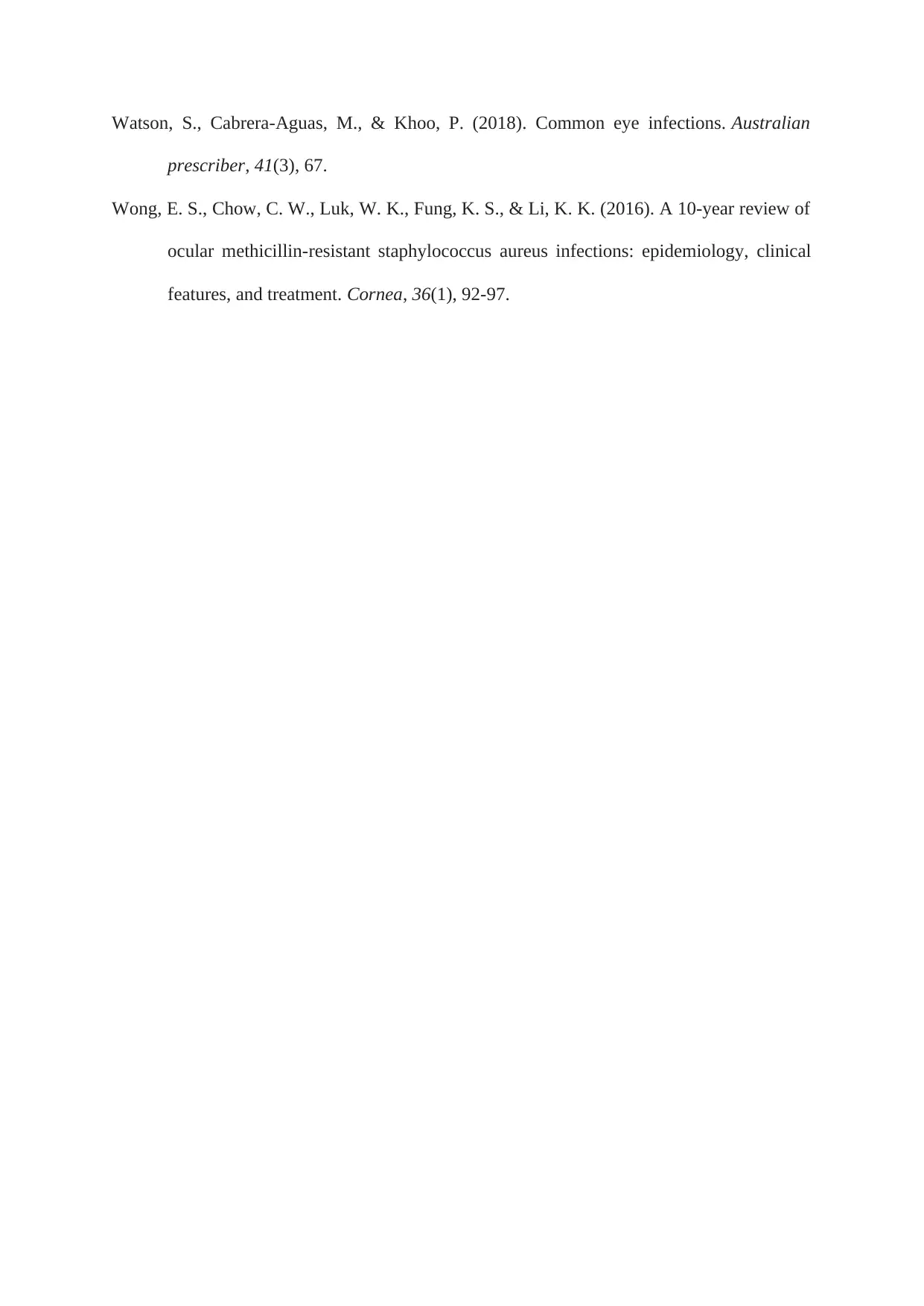
Watson, S., Cabrera-Aguas, M., & Khoo, P. (2018). Common eye infections. Australian
prescriber, 41(3), 67.
Wong, E. S., Chow, C. W., Luk, W. K., Fung, K. S., & Li, K. K. (2016). A 10-year review of
ocular methicillin-resistant staphylococcus aureus infections: epidemiology, clinical
features, and treatment. Cornea, 36(1), 92-97.
prescriber, 41(3), 67.
Wong, E. S., Chow, C. W., Luk, W. K., Fung, K. S., & Li, K. K. (2016). A 10-year review of
ocular methicillin-resistant staphylococcus aureus infections: epidemiology, clinical
features, and treatment. Cornea, 36(1), 92-97.
⊘ This is a preview!⊘
Do you want full access?
Subscribe today to unlock all pages.

Trusted by 1+ million students worldwide
1 out of 9
Related Documents
Your All-in-One AI-Powered Toolkit for Academic Success.
+13062052269
info@desklib.com
Available 24*7 on WhatsApp / Email
![[object Object]](/_next/static/media/star-bottom.7253800d.svg)
Unlock your academic potential
Copyright © 2020–2025 A2Z Services. All Rights Reserved. Developed and managed by ZUCOL.





